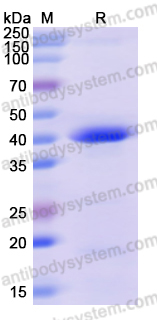Catalog No.
YHK42401
Expression system
E. coli
Species
Homo sapiens (Human)
Protein length
Gly23-Glu333
Predicted molecular weight
37.67 kDa
Nature
Recombinant
Endotoxin level
Please contact with the lab for this information.
Purity
>90% as determined by SDS-PAGE.
Accession
Q9UBS4
Applications
ELISA, Immunogen, SDS-PAGE, WB, Bioactivity testing in progress
Form
Lyophilized
Storage buffer
Lyophilized from a solution in PBS pH 7.4, 0.02% NLS, 1mM EDTA, 4% Trehalose, 1% Mannitol.
Reconstitution
Reconstitute in sterile water for a stock solution. A copy of datasheet will be provided with the products, please refer to it for details.
Shipping
In general, proteins are provided as lyophilized powder/frozen liquid. They are shipped out with dry ice/blue ice unless customers require otherwise.
Stability and Storage
Use a manual defrost freezer and avoid repeated freeze thaw cycles. Store at 2 to 8°C for frequent use. Store at -20 to -80°C for twelve months from the date of receipt.
Alternative Names
APOBEC1-binding protein 2, DNAJB11, DnaJ homolog subfamily B member 11, ERj3p, PWP1-interacting protein 4, ER-resident protein ERdj3, ABBP-2, DnaJ protein homolog 9, EDJ, ERJ3, Human DnaJ protein 9, HDJ9, HEDJ, ER-associated DNAJ, ER-associated Hsp40 co-chaperone, ERdj3, Endoplasmic reticulum DNA J domain-containing protein 3, hDj-9
The role of the co-chaperone DNAJB11 in polycystic kidney disease: Molecular mechanisms and cellular origin of cyst formation., PMID:39530576
Integrating transcriptomics and proteomics to analyze the immune microenvironment of cytomegalovirus associated ulcerative colitis and identify relevant biomarkers., PMID:39192288
Influence of increasing acclimation temperature on growth, digestion, antioxidant capacity, liver transcriptome and intestinal microflora of Ussruri whitefish Coregonus ussuriensis Berg., PMID:38830520
Genotype-phenotype of autosomal dominant polycystic kidney disease in Malta., PMID:38537868
Structural transitions modulate the chaperone activities of Grp94., PMID:38483986
DNAJB11 Mutation in ADPKD Patients: Clinical Characteristics in a Monocentric Cohort., PMID:38275584
Screening the critical protein subnetwork to delineate potential mechanisms and protective agents associated with arsenic-induced cutaneous squamous cell carcinoma: A toxicogenomic study., PMID:38219847
Uromodulin processing in DNAJB11-kidney disease., PMID:38016513
Atypical ADPKD Due to a DNAJB11 Pathogenic Variant: An Educational Case Report., PMID:37867501
Changes in the liver of Tinca tinca under successive domestication using an integrated multi-omics approach., PMID:37354750
Dnajb11-Kidney Disease Develops from Reduced Polycystin-1 Dosage but not Unfolded Protein Response in Mice., PMID:37332102
Extracellular chaperone networks and the export of J-domain proteins., PMID:36581212
Exome Sequencing of a Clinical Population for Autosomal Dominant Polycystic Kidney Disease., PMID:36573973
Autosomal Dominant Tubulointerstitial Kidney Disease: An Emerging Cause of Genetic CKD., PMID:36531871
Knock-Out of the Five Lysyl-Oxidase Family Genes Enables Identification of Lysyl-Oxidase Pro-Enzyme Regulated Genes., PMID:36232621
Exosomal DNAJB11 promotes the development of pancreatic cancer by modulating the EGFR/MAPK pathway., PMID:36209075
Grp94 Works Upstream of BiP in Protein Remodeling Under Heat Stress., PMID:35905823
New Proteins Contributing to Immune Cell Infiltration and Pannus Formation of Synovial Membrane from Arthritis Diseases., PMID:35008858
Targeted next-generation sequencing in a large series of fetuses with severe renal diseases., PMID:35005812
Monoallelic IFT140 pathogenic variants are an important cause of the autosomal dominant polycystic kidney-spectrum phenotype., PMID:34890546
DNAJB11 predicts a poor prognosis and is associated with immune infiltration in thyroid carcinoma: a bioinformatics analysis., PMID:34727750
Autophagy-mediated reduction of miR-345 contributes to hepatic cystogenesis in polycystic liver disease., PMID:34568801
Clinical and genetic spectra of autosomal dominant tubulointerstitial kidney disease., PMID:34519781
Exercise training effects on natural killer cells: a preliminary proteomics and systems biology approach., PMID:33965896
Endoplasmic Reticulum-Associated Biomarkers for Molecular Phenotyping of Rare Kidney Disease., PMID:33671535
A plant reovirus hijacks endoplasmic reticulum-associated degradation machinery to promote efficient viral transmission by its planthopper vector under high temperature conditions., PMID:33647067
Genomic diagnostics in polycystic kidney disease: an assessment of real-world use of whole-genome sequencing., PMID:33437033
Bi-allelic pathogenic variations in DNAJB11 cause Ivemark II syndrome, a renal-hepatic-pancreatic dysplasia., PMID:33129895
Proteins involved in the endoplasmic reticulum stress are modulated in synovitis of osteoarthritis, chronic pyrophosphate arthropathy and rheumatoid arthritis, and correlate with the histological inflammatory score., PMID:32887899
Mutational screening of PKD1 and PKD2 in Indian ADPKD patients identified 95 genetic variants., PMID:32823016
Insights into Autosomal Dominant Polycystic Kidney Disease from Genetic Studies., PMID:32690722
Clinical spectrum, prognosis and estimated prevalence of DNAJB11-kidney disease., PMID:32631624
Urinary ERdj3 and mesencephalic astrocyte-derived neutrophic factor identify endoplasmic reticulum stress in glomerular disease., PMID:32203149
Identification of signal peptide features for substrate specificity in human Sec62/Sec63-dependent ER protein import., PMID:32133789
SDF2-like protein 1 (SDF2L1) regulates the endoplasmic reticulum localization and chaperone activity of ERdj3 protein., PMID:31624144
Key genes associated with diabetes mellitus and hepatocellular carcinoma., PMID:31591054
Bialleleic PKD1 mutations underlie early-onset autosomal dominant polycystic kidney disease in Saudi Arabian families., PMID:31079206
Shutdown of ER-associated degradation pathway rescues functions of mutant iduronate 2-sulfatase linked to mucopolysaccharidosis type II., PMID:30042467
The endoplasmic reticulum co-chaperone ERdj3/DNAJB11 promotes hepatocellular carcinoma progression through suppressing AATZ degradation., PMID:29992839
Understanding the regulatory mechanisms of milk production using integrative transcriptomic and proteomic analyses: improving inefficient utilization of crop by-products as forage in dairy industry., PMID:29843597
DNAJB11: another player in ADPKD., PMID:29777155
Monoallelic Mutations to DNAJB11 Cause Atypical Autosomal-Dominant Polycystic Kidney Disease., PMID:29706351
[Expression and clinical significance of DNAJB11 in epithelial ovarian cancer]., PMID:28752709
The endoplasmic reticulum HSP40 co-chaperone ERdj3/DNAJB11 assembles and functions as a tetramer., PMID:28655754
Endoplasmic reticulum proteins SDF2 and SDF2L1 act as components of the BiP chaperone cycle to prevent protein aggregation., PMID:28597544
Erdj3 Has an Essential Role for Z Variant Alpha-1-Antitrypsin Degradation., PMID:28419579
Members of the Hsp70 Family Recognize Distinct Types of Sequences to Execute ER Quality Control., PMID:27546788
Defining Hsp70 Subnetworks in Dengue Virus Replication Reveals Key Vulnerability in Flavivirus Infection., PMID:26582131
FGFR1 and FGFR2 in fibrolamellar carcinoma., PMID:26259677

